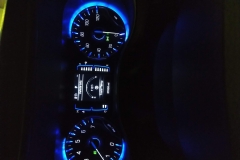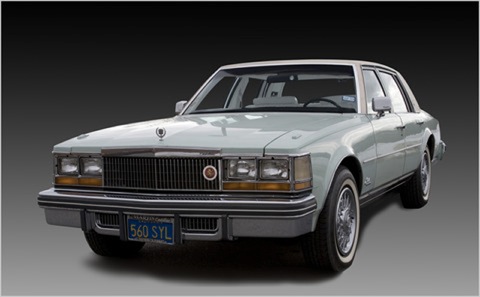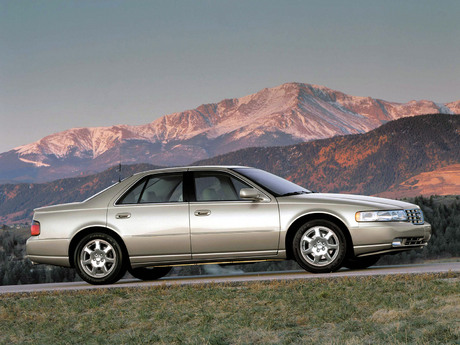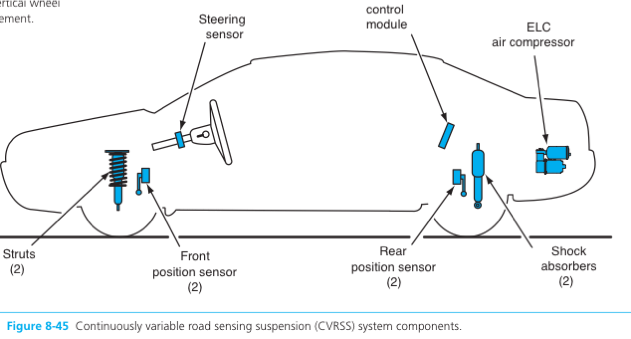




Love hurts.
Love (or lust) causes otherwise intelligent men to marry strippers and whores, and it creates masochists out of car enthusiasts. It is sometimes said that if you’re willing to endure thousands of dollars in annual repair costs to keep your car on the road, you know you’ve got something great (or you’re insane). By that measure, the fifth-generation Seville is outstanding.
The video review is at the bottom of the page.
HISTORY
The Seville was never an ostentatious car, except for the 1980s bustleback design. While the gargantuan 1974 Eldorado was Arnold Palmer’s chariot of choice, the smaller Seville was preferred by Betty White.

Above: Betty White’s 1977 Cadillac Seville
Since 1975, its been Cadillac’s tastefully restrained alternative to European luxury, with sharper handling and more technology than the division’s traditional full-size sedans.
1992 was a year of dramatic change, with the Seville increasing in size and earning awards for its clean, balanced, tuxedo-like styling. 1993 introduced the 300hp Northstar V8, and the Seville became the second-fastest luxury car in its class, bested only by the 6-speed BMW 540i. Autobahn versions were introduced in the mid-90s with Z-rated tires and electronic speed limiters raised to 150mph.
Your average American Seville owner was a doctor or lawyer in his or her 50s with a well-established career, a massive retirement fund, and three children entering college. Demographically, Seville people were nearly identical to Lexus people.
Unfortunately for Cadillac, the older generation that fought two world wars was dying off, and wealthy baby boomers were buying Japanese and German imports. Lexus satisfied America’s working professionals with higher quality cars and exceptional dealer service, becoming America’s top-selling luxury brand in 2000, dethroning Cadillac after decades of dominance.
The Seville never had much of an impact on American culture, likely due to its clean and agreeable image. The Escalade and Deville are revered by urban populations, as depicted in the music video below:
Fast Tube by Casper
[In this song, “Rich Boy” just bought a Cadillac and recommends installing Dayton wire wheels.]
“Seville” earns a few brief mentions in a handful of lesser known rap songs, sometimes in reference to being driven by someone’s father. Don Henley said he once saw a Grateful Dead sticker on a Seville, which he wrote about in the song “Boys of Summer,” in reference to how jarring it was to see a counter-culture sticker on an automobile that represented the establishment.
Unlike the Escalade, the Seville will never become a pop culture icon, which is fine by me.
FIFTH GENERATION DEBUTS
Its not that the 1998-2004 Seville was a bad car. It was outstanding, in theory, but quality was inconsistent. There were published stories of union workers drinking and smoking on the job at GM’s Hamtramck plant and wonky robots that painted each other rather than the sheet metal.
Fast Tube by Casper
Early impressions by the media were generally positive, but long-term reviews were typically negative. Edmunds had nothing but trouble with their 1998 Seville, requiring several dealer visits for squeaks, rattles, steering issues, electrical shorts, paint, peeling buttons, and vibrations.
But Top Gear’s prissy Jeremy Clarkson, of all people, actually praised the Seville’s Northstar V8, calling it “an absolute gem.”
Clarkson went on to say, “I so desperately wanted to savage this car but the engine is too good.” How unfortunate it is that the engine was the most troublesome part of the car. More on that later.
The fifth generation Seville was built on a K-platform derived from Oldsmobile’s G-platform, which underpins the Olds Aurora. The Seville, Aurora, and Buick Park Avenue share several mechanical components including wheel bearings and hubs. Aurora uses a smaller 250 hp version of the Northstar V8.
ELECTRONICS AND TECHNOLOGY
The headlights on all Sevilles are below average. With optional xenon lamps, lighting is adequate. With standard halogens, visibility can be quite poor. Plastic lenses that turn yellow over time require occasional wet sanding to maintain optical clarity.
To the Seville’s credit, it was GM’s testbed for several new technologies including adaptive seating and road-sensing suspension. And the old iteration of General Motors, as we know, has a tendency to release new cars without working out bugs until the end of the production run.
There was an attempt at an early version of an in-dash computer, a rudimentary predecessor to Ford’s Sync system which promised Palm Pilot synchronization and e-mail access (hey, remember PDAs?). The successor to that is the Onstar-based Facebook reader available in the new Chevy Cruze. The infotainment system, slated for 2001, was never released because it was too slow to operate. Engineers blamed Windows CE and the Hitachi HS3 processor.
The Onstar telematics system in older Sevilles uses analog cellular networks and cannot be converted to digital. The cutoff model year is 2003.
Optional adaptive seats had air bladders that actively adjusted to the shape and position of your body. I have yet to try it, but some people have called it creepy. Burn victims and hospital patients, for example, use bed surfaces with air bladders that feel strange at first but offer impressive long term comfort, preventing the formation of bed sores.
The Seville’s Bose 4.0 sound system was a $998 option, with 425 watts, 8 speakers, DSP processing, and wide imaging to simulate live music. The soundstage is so wide that it actually makes the interior feel larger than it is. That width, unfortunately, doesn’t have much height to go along with it. You keep turning it up hoping for a rumble that shakes your chest and hits you like a wave, but it never happens.
The Bose system uses DSP compression that removes a bit of naturalness from music, limiting the frequency range and processing it to produce something that’s more Lady Gaga than Karen Carpenter, which can actually be exciting with the right kind of music. It excels at electronic pop and techno, which are artificially produced to begin with, but rock and symphonic music feel flat. Its as if the system has no idea how to handle real guitars, horns, strings, and drums. Treble sounds a bit artificial and bass feels distant, like the subwoofer is mounted in the car behind you. Still, it was impressive for its time.
The optional Nakamichi system in the competing Lexus LS400 is less powerful but dramatically more detailed. Listening to a jazz band in the Lexus is like taking a handful of magic pixiedust and gently blowing it into the air, then watching it glide to the earth gracefully as it sparkles in the sunlight (I know, quite a bit of imagery). Each instrument is delicately reproduced, picking up not just sounds, but nuances that give recorded music a sense of realism. On some CDs, you can actually hear the air rushing through the chamber as an oboe is blown. The Nakamichi system is truly remarkable, and its the only exciting thing about the LS400, unfortunately.
The Cadillac’s head unit is integrated into the car’s data bus, which means upgrading or replacing the sound system is a chore. Memory and equalizer settings are tied into the key fob and driver profile. This means that when you get into the car, the Seville automatically pulls up your favorite radio station, EQ settings, seating position, steering wheel position, temperature, and feature preferences (horn beep, unlock in park, lock in drive, mirror down in reverse, etc).
It doesn’t always work, unfortunately. Occasionally, my climate control temperature will set itself to 60 and the radio loses its EQ settings.
All 98-04 Sevilles are equipped with Stabilitrak, which makes it darn near impossible to spin out in the snow as I discovered this past winter.
“StabiliTrak 2.0, an improved version of the most advanced integrated stability control system in the world… includes side-slip rate control and active steering effort compensation. Introduced on three performance-oriented Cadillac models in the 1997 model year, StabiliTrak provides an important safety advance by helping the driver maintain control during emergency or evasive maneuvers. StabiliTrak works by comparing the driver’s intentions (indicated by steering wheel position) with how the vehicle is responding. Three key sensors keep the ABS and traction control computer informed: one reads steering wheel angle, another reports the vehicle’s lateral acceleration and the third measures yaw rate (rotational velocity about a vertical axis through the car’s center of gravity). Information is also gathered from vehicle speed.
“If the vehicle’s dynamic response does not agree with the direction the driver is steering, StabiliTrak goes to work by selectively applying the individual front brakes to help keep the car on the intended course. If the car is slipping wide of the desired path in a turn, applying the inside brake helps the vehicle turn tighter. In case of diminished traction at the rear causing the tail of the car to drift wide, activating the outside-front brake gently nudges the car back in line. StabiliTrak is automatic and requires no additional driver action. In most cases, the driver probably won’t even notice the helping hand from this technically sophisticated system….Unlike stability control systems from other manufacturers, Cadillac’s system maintains the driver’s ability to apply throttle in StabiliTrak maneuvers.”
Rear ultrasonic park sensors could be more accurate.
Below is an article from Popular Mechanics about the Bose system.
STYLE
Few sedans on the road look as clean, professional, and balanced as the fourth and fifth generation Sevilles.

Above: Fourth Generation Seville STS, ’92-’97

Above: Fifth Generation Seville STS, ’98-’04
Fourth generation cars are longer, narrower, and have a more Italian look, as they should since they were directly inspired by the Pininfarina-designed Cadillac Allante.
The fifth generation Seville reduces overhangs and widens the car, creating more interior space while making it easier to park. [Unfortunately, the turning circle is a WIDE 41 feet.] The upper beltline flows gracefully into the trunk lid to form the shape of a gently curved lip spoiler. Longer and wider wraparound headlights give the fifth generation Seville a longer, lower look.
There’s something delightfully formal and aesthetically calm about this car, like an art museum. While Mercedes and BMW (and lately, Cadillac) have pursued scoops, swoops, lumps, and humps in desperate acts of attention whoring, the Seville stands the test of time as a tribute to cleanliness, minimalism and good taste. Its a successful interpretation of present-day American design, quite a contrast to the days of tail fins and chrome. The same could be said of the Lincoln LS.
Most importantly, when I walk up to my Seville I think to myself, “Gosh, that’s a beautiful car, and its MINE!” Its a feeling of genuine admiration and satisfaction, something Camry owners may never know.
Fast Tube by Casper
HOW IT DRIVES
The mess of gizmos, gadgets, and sensors attached to the Seville pay off with near-magical ride and handling. Imperfect highway surfaces become smooth sheets of glass and despite the car’s 4000lb weight, it grips corners like a labrador’s teeth on a chew toy.
Unfortunately, despite the Seville’s impressive performance capabilities, its nose-heavy weight distribution and insufficient front seat side bolsters discourage drivers from pushing the car to its limits. In a hard curve, excessive physical effort is placed on keeping the upper body centered, taking focus away from steering and braking. A front wheel drive car of this size has trouble mimicking the neutral handling of a BMW 5-series, where the car rotates around the driver seated at the axis of centripetal forces.
Unlike traditional American cars, the Seville glides down the highway with ease and stability, never wallowing, wandering, or floating thanks to Continuously Variable Road Sensing Suspension and Magnasteer which increases steering effort as speed increases. 2002-2004 Sevilles (later 2002) received Delphi’s Magneride, the same system used by Audi and Ferrari, for sharper cornering and quicker responses to changes in road surfaces. Magneride is faster to respond to changing conditions than CVRSS.

Click here to learn more than you ever wanted to know about CVRSS.
You genuinely feel like you’re dominating the earth, molding the ground beneath you. Part of that is the high-tech suspension system, the rest is perhaps due to the car’s weight.
Steering sensors and G-sensors send data to the PAS (Performance Algorithm Shifting) software, telling the transmission to hold its gear while moving through a curve, as you would with a manual transmission. GM’s 4T80E Hydramatic 4-speed auto is smooth and reasonably responsive, but the Northstar’s preference for top-end passing power makes it feel slightly delayed.
Cadillac’s 300 horsepower 32-valve DOHC Northstar V8 gives the Seville STS slingshot-like acceleration, especially above 3000 RPM. Passing power arrives like a fast-moving thunderstorm, complemented by a throaty, racy, and distinctly American growl. Unfortunately, 2000 and later Sevilles received changes to the intake that reduce engine noise.
The Seville SLS, however, uses different gear ratios and a 275 hp version of the Northstar with more torque for more comfortable around-town driving. Less high-rpm “winding” is necessary to move from a stop.
Premium fuel is required for 93-99, recommended for 2000 and later. Fuel economy is reasonable, 15 city and 25 highway. At 60mph on a flat road with a car in good tune, one could realistically expect 29 mpg. I tend to average 23-24 mpg at 65-70 mph, and see 16-17 in town.
In snow or rain, the Seville is faultless, which explains its popularity in the northeast and midwest. With front wheel drive and Stabilitrak working in unison, its nearly impossible to lose control of the car.
RELIABILITY
Its not all sunshine and roses, unfortunately. As I said earlier, there’s plenty that can break:
–Gadgets and electronic gizmos that stop working
–Electronic suspension
–Head gaskets
–Oil leaks / Rear main seals
–Case half seals
–Bose amplifier and speaker problems
–Water leakage in the trunk (body seam problem)
–Rattles and noises
–Bubbling/bulging dashboard tops
–Front end noise and vibrations
–Crank sensors
–Bad motor mounts
–Misaligned doors and fenders
Some of this is minor. The rattling head rests can be remedied by taking apart the seat and tightening whatever is loose or replacing any clips are missing or broken. Bose amps and speakers can be sent away for low-cost rebuilding. The dashboard tops can be reglued for just a few dollars.
Unfortunately, problems involving the Northstar V8 can be expensive to repair.
A significant quantity of front wheel drive Northstar V8s from 1993 onward have or will suffer from head gasket failure. The root cause is separation between the head and block, due to bolts that inadequately secure the head.
In 2000 and 2003, the head bolts were modified for a more secure grip, which have significantly improved but not completely resolved the head gasket problem. 2006+ front-wheel drive Cadillac DTSes and rear-wheel drive Northstars such as those in the STS, SRX, and XLR seem to be dramatically improved, with far fewer cases of cooling system issues or oil leaks.
The permanent fix for a Northstar head gasket failure is a stud kit, but engine removal is often a part of the repair process due to clearance issues. The transversely mounted Northstar V8 is a tight fit.
Trunk water leaks are nearly impossible to fix, as it has been discovered that the problem is likely attributed to bad body seams rather than bad rubber seals. 1998 and 1999 model years suffer most.
Some Sevilles are affected by these problems, some are affected by a few, while others aren’t affected at all. Its baffling to see some Sevilles blowing head gaskets at 50,000 miles while others cruise past 250,000 with nothing but routine maintenance.
The issue seems to be the variable quality of parts and the inconsistency of the build process at Hamtramck. While the plant is currently an award-winning facility, especially since the turn of the century, it has a checkered past.
The general rule of thumb is that a Seville with a history of problems will have a future of problems. Ask a GM dealer to check the warranty history.
Who should buy a used Seville:
–Hobbyists
–Enthusiasts
–People who can afford expensive repairs
–People with other cars
–The mechanically skilled or masochistic
Who should NOT buy a used Seville:
–Teenagers
–Poor college students
–Single moms (you’ll get hosed by shady mechanics)
–People who need low-cost basic transportation
–Anyone who stumbles on to a buy-here-pay-here lot and uses their last $500 as down payment
RATINGS
Ride: 10/10 — Like glass thanks to thousands of dollars of technology.
Style: 10/10 — Timeless.
Powertrain: 9/10 — The Northstar V8 is outstanding. A quicker-shifting transmission would be nice, but it doesn’t significantly detract from the fun or sense of control.
Braking: 6/10 — Brakes require more pedal effort than they ought to, and lack a sporty bite. Modulation is even and progressive.
Steering/Handling: 7/10 – Front wheel drive has obvious limitations. While torque steer is not an issue thanks to equal length half shafts, most of the Seville’s weight is in front of the driver. Magnasteer does an impressive job of managing steering effort and communicating the road surface to the driver. Technology works overtime (and works well) to compensate for the Seville’s inherent difficulties.
Audio/Accessories: 9/10 — When they work, the array of toys and features make the Seville an everyday pleasure. The Bose sound system is a strong effort for 1998, but by 2001 other manufacturers caught up.
Interior: 7/10 — Materials are nice to touch and nice to look at, but assembly quality is poor. Wide panel gaps and rattles detract from what could have been a world-class interior. Eye-catching Zebrano wood and beautifully flowing surfaces make up for a few cheap plastics.
Comfort: 9/10 — Thigh support is excellent but side bolsters are lacking. The Lexus LS400’s spring-supported seats are slightly better over long distances. The front seats have two seat belts that meet at the buckle, which means leaning forward will not affect belt tension on your waist, and moving your hips will not cause the belt to pull on your neck.
Quality/Reliability: 3/10 — Consistency is a problem. A good Seville is a great Seville that will last forever. A bad Seville is a nightmare. Owners have widely varying experiences. So far, with this 2001 STS, it seems I’ve found a good one. Fifth-generation Sevilles built 2000 or later tend to be better built.
Overall Value: 5.5/10 — Resale value is ridiculously low. This $3800 luxury car with 112,000 miles was about $50,000 brand new only nine years earlier. An equivalent LS430, LS400, or Lincoln LS will cost more to purchase. However, high repair costs will probably make up for any savings. Few cars for less than four grand will make you feel as rich and pampered as a Seville.
VERDICT: Love hurts. It causes us to make irrational, emotional decisions. I know people who will buy a Seville, get tired of its problems, and sell it only to buy another one a few months later. Like alcoholics, maybe we need to form a support group. After having owned and enjoyed more than two dozen different cars, trucks, and SUVs over the past decade, this is the car I continue to benchmark other luxury cars against. Despite everything that goes wrong, I keep coming back.
Specifications at ConsumerGuide
Fast Tube by Casper
http://www.youtube.com/watch?v=e0BSC7E4MYU
Bonus: Driving on the beach in Corpus Christi TX
Fast Tube by Casper
college kid with a seville right here lol
Glad to know I’m not the only one who thinks the Seville’s headlights suck. Really my only complaint with the car. I’ve tried GE Nighthawks, which were a little better, now have Phillips CrystalVision, another incremental improvement. Having the headlights professionally wet sanded soon; did it myself with the 3M kit; results were decent, but I’m sure a professional job will be better.
Spot on for the review. You know how much I adore my Seville for it’s timeless elegance, comfort and performance. I love that it’s fun to drive or utterly effortless — however you want it to be. Giving the Northstar a WOT is still thrilling.
I think mine must have built on one of Hamtramck’s good days. The only fit-and-finish issue I’ve seen in mine is the A-pillar trim on the driver’s side is not completely flush and the front console door is misaligned (the dealer said the spring is probably stretched, but the whole console would have to be replaced; not worth it. My iPod sits on top of it, so it’s barely noticeable. No squeaks or rattles and the interior looks beautiful, especially after I’ve used Pledge on the wood trim and it’s gleaming.
Good to see I’m not the only one who truly appreciates these cars. You should check out the August 2001 issue of Automobile. Very complimentary story on the Seville STS and DeVille DTS.
Does any modern GM engine from this era not suffer from head gasket issues and other coolant leaks? The 3.1 V6 had intake manifold leaks, the 350 in the Suburbans had big head gasket problems, the Northstar had issues…
The 6.6L Diesel, and the 6.2, 6.0, 5.3 and 4.8L truck V8s, and the fantastic 4.2L Inline Six in the Trailblazer platform have never had any major issues with the cooling system. *However* ALL of those, with the exception of the diesel and maybe that I6, suffer from horrible piston slap problems.
The Seville Jesda has pictured above as a 1998 is actually a 2001-2003 with the Luxury Performance package just like his silver one (can tell because of the 17 inch wheels).
A friend of mine had a 93 STS while we were in highschool. He loved that car and he was lucky his parents payed for any repairs. You’re spot on with who should and should not buy one. I think his had somewhere around 175k with no major issues, but it was rear ended and traded in as part of the Cash for Clunkers. Now he’s driving a plain-jane Cobalt, yes quite the change.
I’ve always loved the styling of these Sevilles, and if gas wasn’t so expensive I’d try to get my hands on one.
As gary said, gas, considering the seville has around 300 horsepower, is great, i get an average of 17 city, 25 highway, 23 combined, depending. so dont let gas be the thing to stop you !
Jeff, they’re actually good on gas. I average 22 MPG in a 70/30 mix of highway/city and 25-27 straight highway. I consider that excellent fuel economy for a large, comfortable luxury car with above-average performance. Close to or better than some current mid-sizes with 4-cylinders (I’m looking at you, Buick Regal).
I’ve probably driven more than a dozen Seville’s and every once I drove had one nagging issue or another. If you’re a perfectionist, this is not the car to buy. I learned the hard way with my 2000 STS and every single time something made a noise it was back at the dealer who basically told me to live with it or buy a new damn car. Once my mindset had changed and I actually just drove the car, I really started enjoying it even more. In the past 3 years I have thought about selling my car for something else but I can never actually bring myself to doing it, only because I love the car so much. It’s combination of power, comfort, and elegance cannot be matched by anything on the road today.
I really luv my Cadillac SLS 2000 I purchased it used last year ! It had a few bumps and bruises from its previous owner… like gasket issues, collant resevoir needed replacing and a few older parts needed replacing from normal wear and tear. Tuned her up and she’s running like a sewing machine, ….she’s flying its nothing to be driven 80 miles per hr. without even realizing it on the highway. My son is in college and enjoys driving her more than I do ! Great body… Gotta luv her ! Cadillac all the way.. Driven Mercedes but give me my Caddie. Never saw myself driven one, but fell in luv with her the moment I saw her on the lot !!
From the far Netherlands (europe).
Drove a lot of cars (Mercedes E300, BMW7, Ford, Volvo V70 and XC70, Chrysler 300CRD > most of them diesel) but the Caddy Seville STS is by far the best car I’ve ever had.
Why? Power, comfort, high power Bose soundsystem, high tech road sensing system, the timeless design and so on. My kids also choose the Caddy as the winner….
My Seville had a milage of 360000 km ans is still on the road. Impressive……
You Americans: be proud of it!
I own a 2001 Cadillac SeVille SLS. The car is amazing, its not 100% mine yet, its my grandfathers, but i almost own it. He doesnt take great care of it, at all, so he is slowly letting it fall apart. At 160,000 miles, you need to fix every noise, because they lead to more, but the only problems we have, which are ever since we hit the 150,000 mile mark, were motor mounts, break line rotted out, and Idle Air Control Valve, oh, also a few, very few, electrical issues. Which all may seem like a lot, but remeber, 160,000 miles, thats nothing considered to the problems he said it has. I Will 100% recommend this car to anyone who can afford a more expensive car, it is worth the money you put into fixing it. trust me.
oh, and as a continuation, the sound system is amazing. ^^^
Hello from Munich, Bavaria, Germany!
i am a big US Car fan and owned many mostly GM Cars,
had a 1985 Seville elegante for 16 years,
now i drive a 1999 STS in cashmere, i can remember when i
first saw it at the GM dealer here in town, 112 000 DM the price,
today about 56 000 Euros! i am very happy do drive it, the
timeless elegance is wonderful but it looks American also,
that´s it! Its rare as a Rolls Royce Phantom here on the streets,
so many people turn their heads 🙂 Of course i hope to have a
“good one” with no much issues in the future,
and also hope Cadillac will bring back a new world class car
for the 21 Century soon to match Bentley, Rolls, Mercedes and co,
to set a real new Standard of the World 🙂